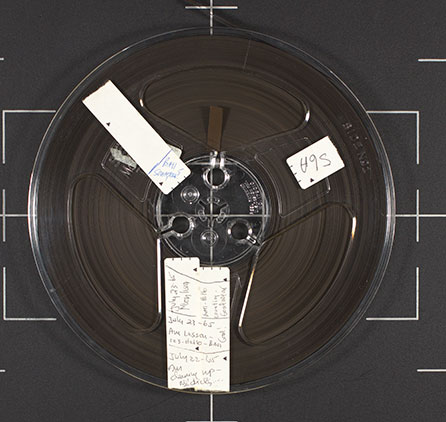| SHORT ABSTRACT: VOICE, BODIES, SOUND, MATTER
This artistic doctoral project inhabits the borders between art and theatre, voice and vision, the animal and the human. It seeks to explore the act of listening from within a visual arts practice. At the heart of the inquiry is a series of artworks that use voice, bodies, sound, narrative material, and environments. Listening is here primarily approached as a problem of embodied interaction with matter. I do not consider listening to be an exclusively sonorous affair, but a mode of interaction, or rather intra-action to speak with theorist physicist and feminist theorist Karen Barad. [1] The listening body is treated as a “mingled body” in which the senses are knotted together, not separated in different channels. [2] What could it mean for a mingled body to be primarily acoustically oriented? What does a listening-seeing body capture when the gaze is no longer dominant? Philosopher Jean-Luc Nancy asks us to consider: “What does it mean to exist according to listening, for it and through it, what part of experience and truth is put into play?” [3] The artworks do not answer these questions, but offers ways to inhabit the problem, and make it felt. In the works, a small group of visitors are situated both in relation to a specific environment and to a non-linear narrative. They are not addressed as a collective; rather they are alone together, sharing a situation but not necessarily the experience. The situated narrative is put in motion by the use of acousmatic voices and sound, the bodies of the visitors, and mediating objects in found or constructed environments. As a visitor you are not asked to listen with your ears only, but to engage a bodily sense of mingling, of confluence (confusion), and thus you become part of the stew, of the very solution (if you catch my drift). [4]
The work method is experimental and performative, it is a thinking-through-practice, which is based on action and perception. I see this process as a “rebooting” and widening of scope with regards to the senses and the sensible, where artistic research potentially could be a site for unlearning rather than mere knowledge production. The body is both a medium and a place of resonance, and listening means being-in-sound – i.e. being in and of the world rather than standing in relation to a world. But the verb to hear also carries echoes of to obey, be in bondage, to belong. Listening thus implies a relationship of power. To lend ones ear to someone is a corporeal act (hypnosis and relaxation exercises could be used to prove the point), but a voice of guidance could easily turn into a voice of command. The opening up to intimacy might therefor also evoke a fear of being exploited. Voices as well as sound cannot be easily fended off. Sound penetrates, merges, overwhelms, immerses. It collapses distinctions such as inside and outside, subject and other, autonomy and manipulation. Listening has consequences for how things are seen.
While I make extensive use of voices, the main focus is neither oral performances nor speech, but the presence of voice in relation to trans-sensory experiences, and how sound and voice structures audio-visual-spatial relations in concrete material situations. The voice is used as a tool to explore intimacy and authority, violence and desire, language, loss, and transformation. One entry into this complex field is offered by the acousmatic voice, i.e. a voice without a body, and a special kind of being that composer and film theorist Michel Chion calls acousmêtre, an invisible character that can be heard but not seen. [5] Another point of entry is offered by the animal “voice”, and attempts to teach animals to speak human language. Not only parrots but also many other species have proved to be vocal learners (e.g. elephants, bats, seals, and orangutans). When speech has failed, sign language or gestures have also been used, and the 1960-70s saw an upsurge in ape language-learning. But to what extent do the animals understand what they are saying? There is a specific instance in the 1950-60s that I constantly tend to gravitate towards, where humanoid sounds were found to emanate from a most unlikely source.
Notes:
[1] Karen Barad, ”Posthumanist Performativity: Toward an Understanding of How Matter Comes to Matter”, Signs: Journal of Women in Culture and Society, vol. 28, no. 3, 2003.
[2] Michel Serres, The Five Senses: A Philosophy of Mingled Bodies, translated by Margaret Sankey, Peter Cowley, Continuum Publishers (New York, 2009)
[3] Jean-Luc Nancy, Listening, translated by Charlotte Mandell, Fordham University Press (New York 2007)
[4] In this drift I’m indebted to Michel Serres again.
[5] Michel Chion, The Voice in Cinema, Columbia University Press, (New York, 1999)
LIST OF ARTWORKS THAT WILL BE PART OF THE DISSERTATION
Limit-Cruisers (#1 Sphere)
A performance for six participants, 60 min.
Inter Arts Center, Malmö, Sweden, 18-20 Sep, 2012 and 24-26 Mar, 2013.
Weld, Stockholm, Sweden, 21-23 Feb, 2014
Limit-Cruisers (#2 Crowd)
A praxis session for listeners and observers, 30 min.
PSi19: Now Then: Performance and Temporality, Stanford University, California, USA, 29 Jun, 2013
In the Greenery
An exhibition comprising three installations:
Fluorescent You, sound, headphones, screens and monochrome light, 18 min.
Therapy in Junkspace, sound, video, headphones, monitor, treadmill, plexi glass booth, carpet, plant, 8:30 min.
Then There the Bark Above Their Shoulders Grew, sound, headphones, vibration speakers, wool mats, wooden construction, 8 min.
Inter Arts Center, Malmö, Sweden, 8-29 Apr, 2016
Articulations from the Orifice
Performance lecture (work-in-progress)
<<
Back to projects |
|
|
